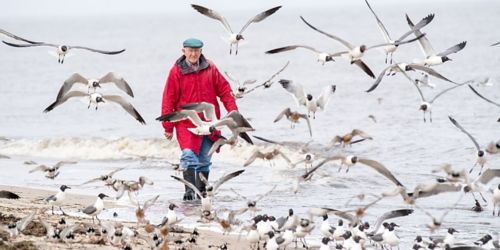St. Jude Family of Websites
Explore our cutting edge research, world-class patient care, career opportunities and more.
St. Jude Children's Research Hospital Home

- Fundraising
St. Jude Family of Websites
Explore our cutting edge research, world-class patient care, career opportunities and more.
St. Jude Children's Research Hospital Home

- Fundraising
Will Mother Nature deal a deadly hand with influenza virus?

Robert Webster walking along the beach at Delaware Bay, where he studies samples of migratory birds as part of annual flu research. The results of this work each year determine what may be included in a flu vaccine.
Will a deadly influenza virus similar to 1918 Spanish flu ever reemerge?
This is the question many public health officials worry about.
Why should we be concerned?
One hundred years ago, people worldwide were afraid to leave their homes. So many people were dying of influenza, many cities had difficulty picking up and burying the dead. Memphis records show that the peak of deaths occurred on October 19, 1918, when 118 per 100,000 people died. No vaccines or medicines were available. Between 20 and 100 million people died worldwide.
The virus causing the global disaster had most probably originated in Kansas as a mild strain that was taken to the World War 1 trenches in France by American troops. The virus morphed into a monster strain which caused people at the prime of life to develop extrememly high temperatures (105-106°F), turn bluish or black from lack of oxygen, and die when their lungs filled with blood. If they survived, there was a high probability of death from bacterial pneumonia.
My father fought in the trenches in France and was wounded. He described the terror of the poison gas clouds. It is possible that the mustard gas contributed to the conversion of a mild virus into the monster strain.
The German commander, Erich von Ludendorff, claimed that it was the virus that caused collapse of the German army. The United States had unwittingly used biological warfare to influence the outcome of World War 1, for many of the U.S. troops had been exposed to the mild strain and were protected.
More about influenza on St. Jude Progress
- This flu season, think of more than yourself
- Cancer drug shows promise against flu
- What is causing resistance to new flu drug xofluza?
How do influenza pandemics happen?
To monitor the ever-changing influenza viruses, the World Health Organization formed a Global Influenza Surveillance Network in 1952. St Jude Children’s Research Hospital was invited to join the network as one of the six Collaborating Centers in 1975 to understand the ecology of influenza viruses, and where pandemics came from.
How and where pandemics of influenza virus come from was a key question after the emergence of the deadly 1918 Spanish flu and the Asian H2N2 pandemic in 1957. Did they emerge by hypermutation of circulating strains or from an animal reservoir? Studies at St Jude Children’s Research Hospital, in conjunction with the World Health Organization network, established that aquatic birds of the world are the main reservoir.
In aquatic birds, the virus replicates predominantly in the intestinal tract, and is shed in high concentrations in the feces. The birds, however, rarely appear sick. There are 16 known subtypes (families) of the flu virus in wild aquatic birds. In the past century, three of those subtypes (H1, H2, H3) have caused pandemics in humans.
Flu virus, birds and human-to-human contagion
There was considerable skepticism that bird influenza could spread and cause diseases in humans. It was hard to understand how an enteric, or intestinal, influenza virus growing in the high temperature of a bird (>40°C) acquires the ability to cause respiratory disease in humans at a lower temperature. This skepticism vanished in 1997. That is when the H5N1 virus that was lethal to chickens also killed 6 of 18 infected persons in Hong Kong. The H5N1 virus spread throughout Eurasia. Today the virus is endemic in poultry in China, Vietnam, Indonesia, Bangladesh, and Egypt. The virus periodically spreads to humans and has infected 860 people, resulting in 454 deaths. The good news is that H5N1 viruses have not yet learned how to spread human-to-human.
In 2013, a second bird flu (H7N9) emerged in people and poultry in Shanghai. This virus initially caused mild infection in chickens but killed up to 40% of humans infected. This virus has also not yet learned how to spread human-to-human, but has caused 1,567 cases with 615 deaths. Recently, the virus has learned how to kill chickens, and has recently spread to domestic ducks, but to date it has not spread outside of China.
How likely is another flu pandemic?
Turning back to the initial question — could an extremely lethal influenza virus like 1918 Spanish influenza emerge today?
You do the calculations ... If H5N1 that kills 52 % of infected people, or if H7N9 that kills 40%, learns to spread human-to-human, the answer is yes. If Mother Nature shuffles a deadly hand, it is well possible.
For more about the 1918 Spanish flu and strategies to prevent or control another potential catastrophe, read Webster's latest book, Flu Hunter: Unlocking the Secrets of a Virus.






